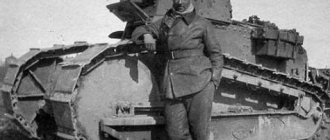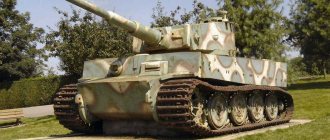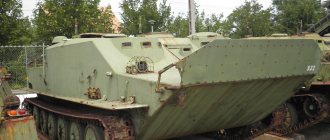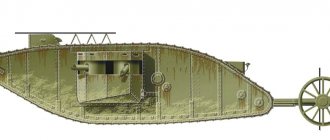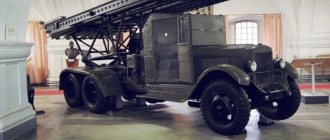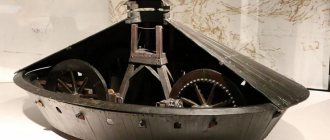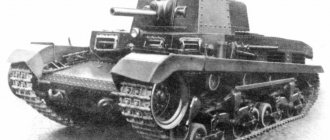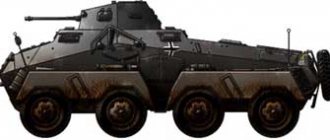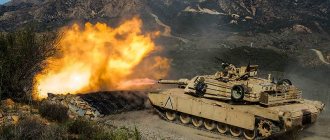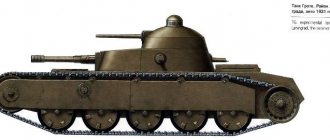True, the design of new armored vehicles was no longer carried out in Leningrad, but in Chelyabinsk, where most of the Kirov plant, including its tank design bureau, was evacuated.
Here is what is said about this in the book “Weapons of Victory” (Machine Building Publishing House, 1987): “In the ChTZ design bureau under the leadership of chief designer Zh.Ya. Kotin, in the winter of 1941-1942, work began on the design of promising modifications of the heavy tank: KV-7, KV-8 and KV-9.” And there was also the KV-13.
This seems incredible, but in the most difficult - the initial period of the war - the country's leadership did not object to experiments with tanks and even allocated considerable material and financial resources for this work.
Themselves with a mustache
The shroud of secrecy that hung over the Soviet military program, oddly enough, constantly hampered Western engineers as well.
Designing good technology without knowing what will oppose it is not an easy task. Before they have time to create a tank that could fight on equal terms with the T-55, the T-62 will appear. As soon as the answer is ready for him, it will turn out that the Soviets have already almost completely rearmed with the revolutionary T-64 and its brother T-72. Therefore, from the late 60s, Western designers decided not to wait for the success of their intelligence officers and tried to get into the shoes of Soviet engineers, independently designing possible Soviet tanks of the future. This program was designated FST-1 - Future Soviet Tank-1.
Reconstruction of the appearance of the T-72, completed in the mid-70s
True stories of Baron Rezun-Great Britain
Before we began, a serious analysis of the history of Soviet tank building and answers to some difficult questions were required. For example, why does the Union produce several types of MBT (main battle tank) at once? The only normal source of information seemed to be defectors from the USSR, including the well-known Vladimir Rezun. It was he who launched the legend about the existence of the most secret Soviet tank - the IT-130 assault gun based on the T-62.
Drawing of IT-130, made personally by Rezun
This “concept” is best described by his own quote:
“Any motorized rifle regiment (in the USSR, but not abroad) has one battery of heavy assault guns. In the 1950s, the powerful D-74 gun (122 mm) was mounted on the chassis of the T-54 tank, then the M-46 gun (130 mm) was installed on the chassis of the T-62 tank. All regiments, without exception, have heavy assault guns of this type. They are stored for decades and never see the light of day. Their crews train on T-54 and T-62 tanks. Sometimes they are shown the scope of an assault weapon. They know the tactics of its use and know how to maintain the engine. If war breaks out, their commanders will report that instead of tanks they will receive similar, but more powerful and armored weapons.”
Reconstruction of IT-130 by Stephen Zalogi
According to Rezun, the purpose of such “secret” batteries of assault guns is either to strengthen the most important areas of attack, or to act as tank barrier detachments behind countless waves of simple Soviet armored vehicles. Of course, it cannot be said that the words of a “true patriot” were accepted in the West without doubt, but the IT-130 he invented and the concept of secret tanks intended for special units lingered in analytics for quite a long time.
Opponent for Abrams
After analyzing the information, intelligence passed it on to engineers from General Motors. They were tasked with posing as Soviet tank designers and designing the next generation tank that would stand up to the future Abrams Block 1 (aka M1A1), tank and man.
After thinking a little, the tank builders made an important conclusion: due to the dense layout, further modernization of Soviet tanks in terms of armor and fire control system (fire control system) is difficult. This means that Soviet tanks are in for serious changes - for example, a new welded turret of the Western type. Yes, it is not as streamlined, but it is easier to protect and accommodate new equipment.
Reconstruction of FST-1
The chassis was left old - it was considered quite effective. A gas turbine engine (gas turbine engine) was chosen as the power plant: in the West there was enough information about the active development of these engines in the USSR. Only in the late 80s did the Americans manage to compare their assumptions about the FST-1 and real new Soviet tanks. The result was mixed.
The USSR chose a completely different path for tank development.
Instead of increasing the thickness of the armor, Soviet developers focused on improving dynamic protection. The United States did not foresee the return of missiles to tanks. But in general, the M1A1 was not inferior to its competitors from behind the Iron Curtain, which means the practice could be continued.
Another take on the FST-1 is a T-85 heavy tank with a rifled gun and reinforced armor. Intended to support the offensive of the T-64 and T-72 tanks, just as the T-10 supported the T-54 at one time
The Loser Twins: The Last Soviet Multi-Turret Tanks
The decade between 1930 and 1940 in the history of world tank building can quite rightly be called the era of general enthusiasm for multi-turret tanks. Since the blitzkrieg phenomenon was still far away, the experience of the First World War suggested that a heavy tank (that is, a breakthrough tank, also known as an infantry escort tank) simply must have the maximum possible weapons - the more guns and machine guns, the better. All that remained was to resolve the issue of the layout and coordination of the actions of the crew of the land dreadnought - back in the “roaring twenties” it became finally clear that the sponsons inherited from the Navy had become completely obsolete with the end of the Great War and the weapons should be located exclusively in rotating towers.
We recently discussed the British A1E1 “Independent” in detail. The tank was completely obsolete by the beginning of World War II, but was the first-born among many projects, the main characteristic of which was a multi-turret. Perhaps the British are the inventors of the tank as such and the authors of the “Independent”, an ultra-modern vehicle for the mid-twenties, but in the end it was the Soviet Union that gave all industrial powers a head start in the field of creating multi-turreted vehicles - just remember that only the USSR was the only one in the world that produced heavy tanks. serial multi-turreted tanks: this implies the T-35 project, related to the aforementioned British one.
Projections of Soviet multi-turret heavy tanks, top to bottom: T-35 SMK T-100 Drawing by A. Aksenov
Another surge of interest in multi-turreted vehicles occurred among the Soviet leadership around 1937–38, and the main factors for the appearance of such serious devices in metal as the T-100 and SMK were the Civil War in Spain and the peculiarities of the production of military equipment in the first workers' and peasants' state .
Let's remember how tanks were designed in Great Britain back then. The War Ministry was developing specifications and basic requirements for the future vehicle - weight, armament, armor, speed, and so on. The specifications were transferred to the manufacturing company, for example the famous Vickers, a team of engineers began to work, and the resulting prototypes were either immediately discarded, or vice versa - they were finalized as much as possible and put into production.
In the Soviet Union, things were somewhat different. Firstly, it was customary to develop new technology on a competitive basis, and not to give a monopoly to one bourgeois capitalist. Secondly, the Spanish Civil War, where armored vehicles were used on a large scale for the first time since 1918, showed that the Soviet BTs and T-26s supplied to the Republicans were too easy a target for anti-tank artillery. Even German 7.92-mm armor-piercing bullets of the SmKH brand of light tanks Pz.I penetrated the armor of the T-26 at a distance of one and a half hundred meters! Based on the Spanish experience, the following conclusion was drawn: the Red Army needs a new tank with shell-proof armor.
However, towards the end of the thirties, the Soviet military and designers began to realize that the five-turret T-35 was a dead end. By 1938, its armor data was already considered insufficient, since anti-tank artillery was rapidly developing. Moreover, the T-35 had a lot of design flaws, among which the constant breakdowns of the transmission and completely insufficient mobility on the ground stood out most clearly, which was a consequence of the large mass and large length-to-width ratio of the tank - another legacy of the First World War: the longer the tank, the he can overcome a wider trench.
T-100 projection drawing
As a result, it was decided to develop a new tank, smaller in size, but with enhanced armor, but they did not decide to completely abandon the multi-turret design. Two design groups in Leningrad - at the Kirov Plant and the Kirov Experimental Mechanical Engineering Plant - were offered a competition: they needed to create a tank weighing 50-60 tons with armor of at least 60 millimeters and a speed above 35 kilometers per hour. Although the designers Joseph Kotin and Semyon Ginzburg, who led the groups, did not work together, but in parallel, two twin brothers were actually born - the Sergei Mironovich Kirov tanks, abbreviated as SMK, and a vehicle with the T-100 index.
Drawing of QMS projections
As was said, the designers considered abandoning the multi-turret concept of a heavy tank, which had prevailed for many years, as too bold and extravagant a decision. The very first version of the SMK had as many as three turrets with one 76-mm gun and two 45-mm guns, respectively. Moreover, the towers were not located along the longitudinal axis, but offset, front to the left, rear to the right, for a wider sector of fire. Comrade Stalin, having examined the model in December 1938, was dissatisfied and considered the rear turret of the SMK unnecessary. Which, however, was quite fair, and Joseph Kotin himself had no objections. The design was simplified - a machine gun was added to the main turret for protection from the rear, mounts were provided for an anti-aircraft machine gun, and the saved weight was used to strengthen the armor. To be fair, it must be said that the “twin” T-100 was also originally designed with three turrets, but even at the sketch stage it became clear that the tank’s weight exceeded the planned one, and the third turret was removed.
T-100 reservation scheme
The question arises: why such difficulties? Multi-tiered weapons, two guns? It should be recalled that at that time, a KV of a normal configuration was in parallel development - that is, a very ordinary heavy tank with good armor and one turret with a powerful gun capable of anti-tank warfare?
And again and again we are faced with the difficult legacy of the First World War and the theory of an assault tank, obliged to break through the enemy’s layered defenses. The main turret cannon fights enemy pillboxes, while the 45mm gun is used against infantry and lightly armored targets. However, already during the tests it became clear that it was difficult for the commanders of the SMK and T-100 to control the fire of guns and machine guns in two towers at once. The T-100 was equipped with a TPU-6 internal intercom, which was quite progressive for those times, and the machine-gun turret was equipped with a flashing device, but this did not help - the commander does not have eight eyes to keep track of all directions.
T-100 at the training ground, autumn 1940
SMK, ibid.
Completely similar problems arose with the SMK tank designed by the famous designer Joseph Kotin. The third tower, which was included in the project, was removed at the suggestion of Stalin, who insisted on simplifying and lightening the design to fifty-five tons, as opposed to the original sixty. In any case, the tank turned out to be overweight and too large, which affected the operation of the new chassis and, of course, visibility - the SMK was an excellent target. The conclusion was completely obvious: we need to be more modest and create a version of a heavy tank on a shortened chassis, with a redesigned hull and one turret. The project was named KV and went into operation at the beginning of 1939 - it was this vehicle that would forever put an end to the development of multi-turret tanks.
One way or another, both the T-100 and SMK entered testing in August 1939. The SMK really showed the calculated characteristics - the maximum speed on the highway was 35.5 km/h, the power reserve was at the design level, and in terms of driving performance it surpassed the T-35. Problems, as expected, arose with the chassis, since the car turned out to be too heavy. The T-100 was criticized by the state commission: the design imperfection of the transmission with servos, the unstable operation of the cooling system, the poor reliability of the fan and the poor design of the cooling grids were noted.
How the QMS was arranged internally
Separately, we note that together with both vehicles under discussion, a KV prototype was tested, which made an incomparably better impression: with a significantly lower mass, the Klim Voroshilov had similar weapons with the ability to conduct all-round fire and better armor... It was on this that the commission’s attention was focused.
* * *
And soon the opportunity arose to test the latest vehicles in real combat conditions. The Finnish War began, Soviet troops stood in front of the well-known Mannerheim Line, which was extremely difficult to break through without heavy assault tanks. All three new products were sent to Finland - both double-turret tanks and the KV from the Kirov plant. The Soviet command reasoned quite sensibly: armored vehicles with projectile-proof armor could significantly help the troops, and designers would be able to identify existing shortcomings right on the spot. The very first battle on the Mannerheim line showed that all three vehicles were invulnerable to Finnish artillery - the 37-mm Bofors cannons did not penetrate armor in any projection.
Scheme of combat operations of SMK and T-100 tanks in the Summa - Khottinen area on December 18–19, 1939
I would like to make a small remark. It is very strange that three of the newest, frankly speaking, secret tanks went on the attack on a narrow section of the front. Everyone remembers what happened to the first German “Tigers” at the front near Leningrad in 1942 - when, after the very first combat use, the Germans lost several “Tigers”, and the Red Army soldiers dragged one of the tanks to their rear, allowing Soviet specialists to quickly examine the vehicle and find ways to counter heavy and well-protected German tanks.
In our case, something similar happened - SMK, T-100 and KV tanks on the day of December 17, 1939 supported the advancing infantry during the assault on the forward pillboxes of the Khottinensky fortified area in the Summa-Khottinen zone. The SMK easily overcame the obstacles and barbed wire; in total, the tanks suppressed three machine-gun bunkers and drove to the Finnish observation post. Interestingly, the single-turret KV showed the greatest accuracy and firing efficiency.
Then the trouble started. The SMK was blown up by a landmine and was immobilized - the caterpillar, sloth and transmission were damaged, and the bottom bent. The crew was practically unharmed. It was not possible to pull out the SMK - the tankers left the tank through the lower emergency hatch and crawled into the T-100, which, together with the KV and the T-28 accompanying them, retreated.
Soviet heavy tank SMK, which was blown up by a landmine on the Karelian Isthmus
You can imagine how happy the Finns were - such a trophy! However, it was not possible to capture the tank: the SMK turned out to be too heavy to tow, and the Soviet artillery set up a fire barrier around it. One curious thing is connected with this: Finnish scouts still made their way to the tank at night, examined it and even unscrewed the top hatch from the turret. One problem: the hatch was, as they would say now, “counterfeit” - Joseph Kotin recalled that before assembling the prototype QMS, one hatch cover was not enough, there was no time to wait for its delivery, and the craftsmen of the Kirov plant made the cover themselves, using steel for this, at their disposal. It was this cover that, through the Finns, fell into the hands of German intelligence, which ultimately made completely incorrect conclusions about the quality of the armor of the newest Soviet heavy tanks.
Let us give the floor to A.P. Kunitsyn, a participant in the above-described battle, a motor mechanic who also served as a loader on the SMK tank:
...Through the viewing slot, the driver Ignatiev could clearly distinguish the road. The tank, crushing trees and scattering rubble from thick, specially felled trunks, moved forward. So he broke through a row of wire fence, crawled across the ditch and approached the granite gouges. With slow movements from side to side, Ignatiev began to swing and push apart the massive granite gouges. The Finns methodically fired from anti-tank guns. There was a terrible roar inside the car. The impact of the shells on the armor caused pain in the ears, but the crew did not detect a single hole. The enemy intensified the fire, but not a single shell could penetrate the body of the vehicle.
It was extremely difficult for both the commander and the driver to control the vehicle under fire on such a difficult track. The soot and smoke made my throat sore and my eyes watered. But the crew continued to fight and boldly led the tank straight up to the enemy pillbox. From both turret guns, the tankers fired at the embrasures and also fired from machine guns.
The fight was terrible. Our car is so thick-skinned, completely impenetrable. But the number of shell hits, mostly from small-caliber artillery, we received from the QMS was about a dozen and a half. After the battle we returned to our original positions. The next day the attack was repeated twice, we returned to our original positions, but soon received orders to help our units that had broken through to the Summa area. We equipped our “flagship” vehicle with SMK, KB and T-100. We went forward in a column. At the same time they fired at the pillboxes. The Finns, it must be said, used all sorts of tricky methods of fighting: suspended mines, various traps made of foreign objects, rubble on the roads
.
An attempt was made to evacuate or restore the mobility of the damaged SMK, but it was not possible to restore the tracks or tow it to the location of Soviet units using a cable. SMK remained in front of enemy positions until the end of the Finnish War. The T-100 took part in several battles, and caused serious criticism regarding the accuracy of fire. When the truce came and the Finns retreated to a new border, the SMK was towed to the railway station with the help of six medium T-28s, but it was not possible to load it onto the platform. The car was disassembled, sent to the Kirov plant for research, and there it was finally declared unpromising. The era of multi-turreted tanks ended, and they were replaced by a more advanced model - the KV-1.
SU-100Y. Based on a person's figure, you can estimate the size of the equipment
In the finale, I would like to say that, unlike the British Independent, the two “twins” at least managed to fight.
Unfortunately, none of these tanks have survived, and we can only get an impression of the dimensions of the vehicles from photographs and the chassis of the SU-100Y, which is in the Kubinka Museum. Alas, the SMK and T-100 were indeed huge, with an unacceptably large silhouette. The later German “Tiger” was comparable to the “twins” in mass, but had a much smaller size. However, Soviet design bureaus gained unique experience, especially in the development of tracked chassis with torsion bars, which was further used on heavy tanks, and the “grandson” of SMK “Klim Voroshilov” launched the creation of many vehicles, including the IS series. Published in the author's edition
Kremlin dreadnought
The development of a new tank in the United States began in the mid-80s and immediately began to study the Soviet enemy for it. This work was called FST-2 (Future Soviet Tank-2). The main idea: Soviet designers will maintain the tightest possible layout of the tank at any cost. This means that they will have to abandon the traditional scheme and move on to something new.
The main option was a tank with an uninhabited turret and a crew in the hull. The main weapon was supposed to be the latest smooth-bore 135-mm Rapier-4 cannon with a new type of automatic loader. Western analysts thought that the USSR would specifically use a new caliber of gun to avoid confusion with artillery shells. This concept was also “discovered” by Rezun.
In the press, FST-2 was called the “Kremlin Dreadnought”. Should have made all tanks obsolete
There were also alternative options. Thus, some analysts were inclined to believe that the USSR would not complicate tanks with uninhabited turrets. Improved armor protection can be achieved by placing more dynamic protection on the vehicle and replacing the carousel autoloader with a conveyor loader in the turret niche. The resulting tank was dubbed Premium Tank-5. Previous Premium Tanks were called T-34, IS-3, T-64, T-80, which - according to the author - changed the situation on the battlefield just by their appearance.
Premium Tank-5
FLOATING WHEEL-TRACKED TANK PT-1
0
In 1932, under the leadership of Nikolai Astrov, plant No. 37 developed an amphibious wheeled-tracked tank with cannon armament, unique for its time. The starting point for the creation of this vehicle was the Christie tank, the future BT, recently purchased in the USA. The new tank, designated PT-1, at the time of its creation was superior to all foreign vehicles of a similar class in firepower, security and performance. The armament consisted of a 45-mm cannon and three DT machine guns. On caterpillar tracks the speed was 62 km/h, on wheels - 90 km/h, afloat - 6 km/h. The launch of such a successful machine into mass production was prevented by the technical backwardness of Soviet industry at that time. The chassis was especially complex: it had eight gearboxes located in the wheels. Also, the manufacture of shafts and angular gears was associated with great difficulties. Therefore, in 1935 they decided to stop further work in this direction.
